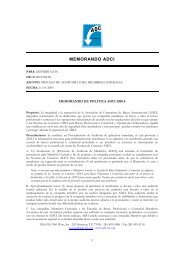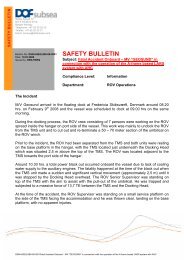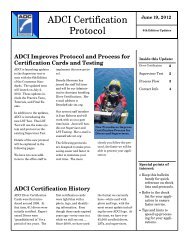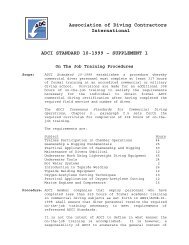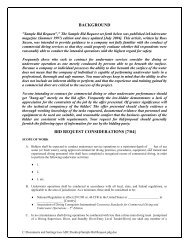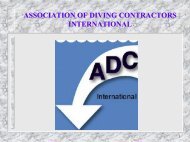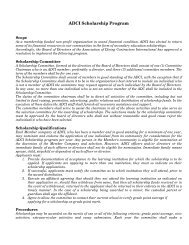DIRECTIVE NUMBER: CPL 02-00-151 EFFECTIVE DATE ... - OSHA
DIRECTIVE NUMBER: CPL 02-00-151 EFFECTIVE DATE ... - OSHA
DIRECTIVE NUMBER: CPL 02-00-151 EFFECTIVE DATE ... - OSHA
Create successful ePaper yourself
Turn your PDF publications into a flip-book with our unique Google optimized e-Paper software.
kept for the divers on one record. However, if the divers have different dive<br />
exposures or use different decompression tables, then separate entries must<br />
be made for each diver.<br />
b. 29 CFR 1910.423(d)(3). For each dive in which decompression sickness is<br />
suspected or symptoms are evident, the following additional information<br />
must be recorded and maintained: a description of decompression sickness<br />
symptoms (including depth and time of onset); and a description of<br />
treatment results. The information required also shall be recorded on the<br />
<strong>OSHA</strong> 3<strong>00</strong> Log (“Log of Work-Related Injuries and Illnesses”). Employers<br />
shall maintain a log of recordable work-related injuries and illnesses. The<br />
key word is “recordable.” The purpose of this requirement is to document<br />
recordable illnesses, including incidents of decompression sickness, even<br />
when the initial symptoms include such manifestations as skin itch, slight<br />
joint cramps, and slight numbness of the extremities. Although seemingly<br />
innocuous, these symptoms are recognized and suspected as mild forms of<br />
decompression sickness. Symptoms and treatments must be recorded<br />
similarly to any other injury or illness. Refer to Appendix G, of this<br />
instruction, for additional reporting and recordkeeping guidance, including<br />
the exemption for commercial diving operations.<br />
4. 29 CFR 1910.423(e) Decompression procedure assessment. This paragraph<br />
requires the employer, within 45 days of occurrence, to investigate and evaluate<br />
each incident of decompression sickness, to take appropriate corrective action,<br />
and to prepare a written evaluation assessing the incident. The corrective action<br />
may include an adjustment of the dive procedures, reassessment of the<br />
decompression tables, or a reexamination of the particular dive involved. A<br />
check of the dive records should show whether an incident occurred that<br />
required an investigation, corrective action, and a written evaluation.<br />
H. 29 CFR 1910.424 – 1910.427 Specific Operations Procedures.<br />
The requirements of 29 CFR 1910.424 through 1910.427 are in addition to any other<br />
applicable requirements in 29 CFR Part 1910, Subpart T.<br />
I. 29 CFR 1910.424 SCUBA diving. Because a SCUBA diver has a limited breathing<br />
supply, does not usually have voice communication, and often is not monitored or<br />
controlled by surface-support personnel, the limits on this mode of diving are more<br />
stringent than for other diving modes.<br />
1. 29 CFR 1910.424(b) Limits.<br />
a. 29 CFR 1910.424(b)(1) and (b)(2). The limits for SCUBA diving are more<br />
restrictive than for surface-supplied air diving or mixed-gas diving (see<br />
Appendix H). The maximum depth for SCUBA diving is 130 fsw (see 29<br />
CFR 1910.424(b)(1)). A decompression chamber is required (i.e., available<br />
within 5 minutes from the dive location) when diving deeper than 1<strong>00</strong> fsw,<br />
or when diving outside of the no-decompression limits (see 29 CFR<br />
27


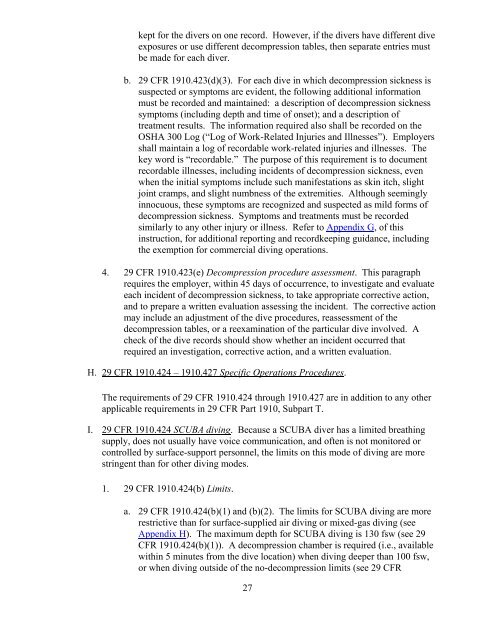
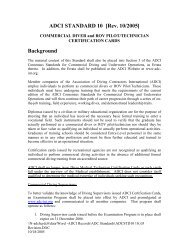
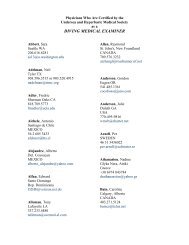
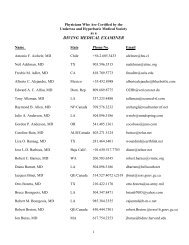
![SOLICITUD MEMBRESIA ASOCIADO [Rev 06/08] - Association of ...](https://img.yumpu.com/48291988/1/190x245/solicitud-membresia-asociado-rev-06-08-association-of-.jpg?quality=85)

